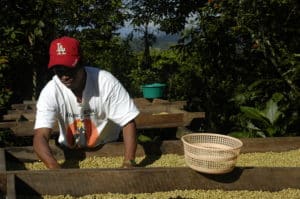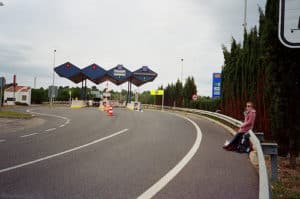
“I tried to buy a ticket too, but they’ve run out of seats,” says the only other Gringo on the bus.
There has to be 200 of us packed into this former American school bus. And without a ticket, this means we’ll be standing for the two-hour haul over the mountains to Matagalpa. This is our first time on an “express” bus, as opposed to the “ordinario” or “chicken” buses which do not require advance purchase or have seat numbers.
The overhead luggage racks are loaded, children are sitting on laps, the central aisle is filled with standers. Our bags have already been hoisted up to the roof-rack and secured under a tarp. As we wait to pull out, sweat drips down my face and most everybody else’s as well.
We’ve spent the past day-and-a-half in the colonial city of Leon—church hopping and museum visiting—making this the first time we’ve done any traditional sightseeing.
Nearing sundown and already into the higher elevation, a cool breeze blows in the window. About half of those on the bus have gotten off, so we’re properly filled now without any people standing. From the window, Emolyn points out the vegetables in the street stall that we’re seeing for the first time: beets, carrots, potatoes, green onions. We roll through Sebaco and let a few more passengers off; the bus driver’s assistant lowers a bicycle and some wooden furniture from the roof down to a girl below.
At twilight, we pull into the mountain town of Matagalpa. Within ten minutes we’ve checked into the Hotel Alvarado, a family-run guest house with adequate $10 rooms. For a little city, Matagalpa is lively: the sidewalks are crowded and music is pouring out of almost every shop. We head to Cafe Artisano right away, which our guidebook describes as “the bohemian hang of choice”. Dehydrated from our bus ride, we opt for a cold pinolillo—a toasted, milled corn drink with pepper, cloves, and cacao—over a beer or coffee drink.
For dinner, we move on to a comedor, an inexpensive cafeteria-like restaurant that serves out plates of typical Nicaraguan food. We fill up for $2 apiece. For a beer we head to Picoteo Cafe, a packed bar/cafe with wooden paneling and a low ceiling. It is smoky inside. A litro bottle of Victoria costs less than $2 and lasts the two of us the entire evening. A three-man band including a guitar, bongos, and a giant bass-like guitar are playing tunes for different tables. I´m wondering if they´re playing for tips or hired by the bar when Emolyn adds “they´re like a jukebox.” The tables pay them in advance for requested songs.
At 7:40 the next morning we´re back on the big yellow bus headed for San Ramon, a village 12 km to the east. Gifford, the general manager of Finca Esperanza Verde has agreed to meet us and take us up to the farm. FEV is a working farm, an eco-lodge, and a non-profit. At 1,180 meters, its 100 plus acres have hiking trails that wind through a steep second-generation cloud forest.
Shortly after arriving, as we’re having a cup of FEV’s finest organic coffee, two men and a woman arrive in a truck from Managua. Within minutes, the guy with the huge Nikon hanging around his neck asks if he can take our photograph for the Nicaragua Tourism Association. After all, we are the only guests here and we look relaxed, sipping our coffee looking out to the spectacular mountain view.
He snaps away and then we follow him down to the small coffee bean processing area of the farm and he continues photographing. The model, a woman in a dress, poses with a big smile and glides her fingers sensually through the green coffee beans drying on a rack. But we are more interested in the processing. The beans are picked shiny green and red around December, then de-pulped, fermented for 40 hours, soaked in water and stirred with a wooden paddle, and dried on-site. Further down in Matagalpa they are sun-dried longer, sorted again, graded, cupped, and shipped out.
FEV sells about 10,000 lbs. of coffee per year and gets about double the price of conventional beans because they’re certified organic. They export directly to Counter Culture Coffee, based in Durham, NC which sells it as Café San Ramon.
We enjoy our two days at the lodge: hiking in the rain, reading and writing under cover of the pavilion, drinking coffee in the mornings, trying to stay warm at night.
Sunday morning we pass the butterfly research center as we pull out from the farm, and start down the hill in the extended cab Toyota pickup. Just then we hear a loud, deep howling from the trees. Giff slams on the brakes and points into the forest—it’s a Howler Monkey. We get a good look at him and continue on our way.
At the bottom of the hill, we get out to the main dirt road, and Giff gets out. He’s playing a game of the Nicaraguan national obsession today and hoping the afternoon won’t be as rainy as the morning was. Yes, it’s baseball day today, and half the team is already standing in the back of another pickup dressed in mismatched nylon jerseys, ready to play.
Another employee of the farm hops in the driver’s seat and shuttles us the 18 kilometers down to San Ramon with beautiful mountain views the whole way.





Stephen, you are an eloquent writer, weaving in bits of detail that reel in the reader. Look forward to reading and learning more. I wish you more success on the site.
.-= Nomadic Chick´s last blog ..Isn’t 6 Months Kinda Early? =-.
Pingback: Ask GoMad Nomad: Little money, still want to travel | GoMad Nomad Travel Mag